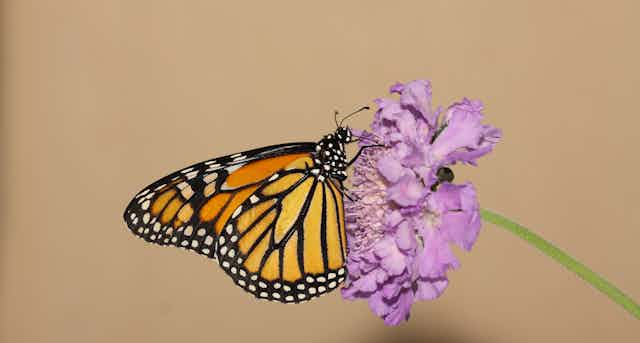Monarch butterflies are known for their striking flame-orange and black appearance, and especially for their mass migration in their millions to spend winters in the mountain forests of Mexico. But despite growing problems with deforestation in Mexico, their struggle begins at home in the United States and Canada.
The butterflies that fly to Mexico are the great-great-great grandchildren of the monarchs that were in Mexico the previous winter. In 2013 the overwintering population in Mexico covered 0.67 hectares of fir forest (about 44 million butterflies) the lowest since counts began in 1994. Since 1999 their numbers have declined 82%.
What could have caused this? During their larval stage monarchs, which can be found from the US central states to the east coast and into southern Canada, feed exclusively on milkweed plants. We observed in 2001 that many monarchs were feeding on milkweeds in agricultural fields – more than 80% of monarchs from the Midwest. Since then, milkweeds in and around agricultural crop fields have gradually been eliminated, through a combination of spraying with Roundup (glyphosate) herbicide and increased planting of corn and soybeans genetically modified to be resistant to the herbicide.
In previous studies, we’ve shown that the magnitude of monarch population decline in Mexico matched the magnitude of the decline in the abundance of milkweeds in butterflies’ prime breeding habitat – the Corn Belt region of the US. This strongly suggests that milkweed loss is the primary factor in the species’ decline.
In a recently published paper, Tyler Flockhart and colleagues in Canada and Australia examined the monarch population decline and tried to gauge the relative roles of all the factors that may lie behind it. Besides the loss of milkweeds in the breeding area, these include climate change, the loss of forests at the overwintering sites, and occasional catastrophic weather events.
The research team developed a population model that incorporated information about birth and death rates for each of the roughly four generations that comprise the monarch annual migration cycle. A number of pieces of information necessary to generate such a population model are unknown or poorly known, so assumptions had to be made. With that caveat, they were able to confirm that the primary driving force behind the population decline was loss of milkweeds in the breeding area, with the other factors playing a minor role.
With population models, not only can you examine the past but also extrapolate into the future. The good news is that the population model projects the population to decline by only a further 14% over the next century – much less than the precipitous drop in numbers over the last 20 years. The bad news is that the new, much lower population level makes the species more vulnerable to events such as catastrophic heatwaves or severe winters that can wipe out millions at a stroke. The model puts the chance of population extinction in the next century at a low but distinctly non-trivial 5%.

The chief reason why future declines will not be as pronounced is because milkweeds have been virtually eliminated from farmland, meaning that losses stemming from that habitat have already been accounted for. At present there are two main habitats that provide milkweeds for monarch butterflies.
The Conservation Reserve Program (CRP) provides incentives to farmers to set aside land from growing crops. This land is typically planted with grasses to prevent erosion but often has milkweeds. I have estimated that there are 1.4m hectares (3.6m acres) of CRP land in the Midwest providing suitable milkweed habitat – if there were incentives for farmers to plant milkweed on their CRP land, this could prevent further declines and even promote a population comeback. Unfortunately at present the high demand for corn means farmers are tempted to convert CRP land back to crops.
The second important habitat is roadsides. Transportation Department officials need to be informed about the impact of roadside management practices, such as spraying with herbicide and mowing, on monarchs.
Incentives to plant other flowering species besides milkweed in CRP land and roadsides would help. Pollinators such as bees and butterflies are in serious decline, largely due to loss of habitat. Other threats to pollinators such as the widespread use of insecticides such as neonicotinoids could also be eliminated.

